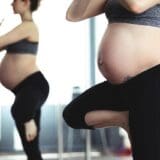Pregnancy is a beautiful and transformative journey for expectant mothers. It is a time filled with excitement, anticipation, and joy. Along with the physical changes that occur during pregnancy, it is essential for expectant mothers to prioritize their health and well-being. One way to do this is through regular exercise.
Exercise during pregnancy offers numerous benefits for both the mother and the baby. It helps improve mood, reduce pregnancy discomfort, and promote overall health. Engaging in safe and appropriate workouts can also prepare the body for the physical demands of labor and aid in a smoother postpartum recovery.
Before embarking on any exercise routine, it is crucial to consult with your healthcare provider. They will assess your individual circumstances and provide guidance on the types and intensity of exercises that are safe for you and your baby. Your healthcare provider will consider factors such as your medical history, any pregnancy complications, and your fitness level.
Safe cardiovascular exercises are an excellent choice for expectant mothers. Low-impact activities like walking, swimming, and stationary cycling can help maintain cardiovascular fitness without putting excessive strain on the joints. These exercises also promote blood circulation, which is beneficial for both the mother and the baby.
Walking is a simple yet effective exercise that can be easily incorporated into a daily routine. It is a low-impact activity that helps strengthen the heart and lungs, improve circulation, and boost overall mood. Walking also provides an opportunity to enjoy some fresh air and connect with nature.
Swimming is another fantastic option for expectant mothers. It is a low-impact, full-body workout that helps relieve swelling and joint pain. The buoyancy of water supports the weight of the baby, reducing strain on the joints. Swimming also provides a refreshing and relaxing experience, allowing expectant mothers to unwind and destress.
In addition to cardiovascular exercises, strength training is also beneficial during pregnancy. However, it is important to use light weights or resistance bands and focus on maintaining muscle tone rather than building significant strength. Strength training exercises help prepare the body for the physical demands of labor and can alleviate pregnancy-related back pain.
Prenatal yoga and Pilates classes are specifically designed for pregnant women. These classes focus on gentle stretching, strengthening, and relaxation techniques. Prenatal yoga helps improve flexibility, balance, and posture, while Pilates targets the core muscles and promotes overall body strength. These exercises also emphasize deep breathing and mindfulness, which can be beneficial for managing stress and anxiety during pregnancy.
When engaging in exercise during pregnancy, it is important to prioritize safety and comfort. Listen to your body and modify exercises as needed. Avoid overheating by wearing breathable clothing and staying hydrated. It is also advisable to avoid exercises that involve lying flat on your back after the first trimester, as this can compress blood vessels and reduce blood flow to the baby.
By incorporating safe workouts into your pregnancy routine, you can enhance your overall well-being and promote a healthy pregnancy. Remember to always consult with your healthcare provider and make informed decisions based on your individual circumstances. Enjoy this special time and embrace the benefits of exercise for both you and your baby.
Benefits of Exercise During Pregnancy
Regular exercise during pregnancy can have numerous benefits for both the mother and the baby. It is important to note that every pregnancy is unique, and it is essential to consult with your healthcare provider before starting any exercise routine. However, for most expectant mothers, incorporating safe and appropriate exercises into their daily routine can have a positive impact on their overall health and well-being.
One of the significant benefits of exercise during pregnancy is its ability to improve mood. Pregnancy can bring about various hormonal changes that can lead to mood swings and feelings of anxiety or depression. Engaging in regular physical activity releases endorphins, also known as “feel-good” hormones, which can help alleviate these symptoms and promote a more positive mental state.
Exercise can also help reduce pregnancy discomfort. As the baby grows, the mother’s body undergoes significant changes, such as weight gain, increased blood volume, and hormonal shifts. These changes can lead to common discomforts like back pain, swelling, and fatigue. However, engaging in appropriate exercises can help strengthen the muscles, improve posture, and increase flexibility, which can alleviate these discomforts and make the pregnancy journey more comfortable.
Furthermore, exercise promotes overall health for both the mother and the baby. Regular physical activity during pregnancy can help improve cardiovascular fitness, maintain a healthy weight, and reduce the risk of gestational diabetes and high blood pressure. It can also enhance circulation, which is essential for delivering oxygen and nutrients to the baby.
In addition to these benefits, exercise during pregnancy can also help prepare the body for labor and delivery. Strengthening the muscles, especially the core and pelvic floor muscles, can aid in the pushing stage of labor and facilitate a smoother delivery. It can also contribute to a quicker postpartum recovery.
Overall, regular exercise during pregnancy is highly beneficial for both the mother and the baby. It can improve mood, reduce pregnancy discomfort, promote overall health, and prepare the body for labor. However, it is crucial to consult with a healthcare provider to ensure that the chosen exercises are safe and appropriate for your specific pregnancy.
Consulting with Your Healthcare Provider
Before starting any exercise routine during pregnancy, it is crucial to consult with your healthcare provider to ensure it is safe for both you and your baby. Your healthcare provider will be able to assess your individual health status and provide guidance on what types of exercises are suitable for you.
During the consultation, it is important to discuss any pre-existing medical conditions, previous pregnancy complications, or any concerns you may have. Your healthcare provider will take into consideration factors such as your overall health, the stage of your pregnancy, and any specific risks or limitations you may have.
They may also provide you with specific guidelines or restrictions to follow during your exercise routine. It is important to follow these recommendations to ensure the safety and well-being of you and your baby.
Remember, every pregnancy is different, and what may be safe for one person may not be safe for another. Your healthcare provider is the best person to provide personalized advice based on your unique circumstances. So, before you start any exercise program, make sure to consult with your healthcare provider for their professional guidance.
Safe Cardiovascular Exercises
Safe cardiovascular exercises are an essential part of maintaining overall health and fitness during pregnancy. These low-impact activities provide numerous benefits for expectant mothers and their babies. Walking, swimming, and stationary cycling are excellent options for maintaining cardiovascular fitness throughout pregnancy.
Walking: Walking is a safe and effective exercise that can be easily incorporated into a daily routine. It is a low-impact activity that helps improve cardiovascular health, strengthen muscles, and maintain a healthy weight. Walking also provides an opportunity to enjoy the outdoors and relieve stress, promoting both physical and mental well-being.
Swimming: Swimming is a highly recommended exercise for pregnant women due to its low-impact nature. It provides a full-body workout without putting excessive strain on the joints. Swimming helps relieve swelling and joint pain, which are common discomforts during pregnancy. The buoyancy of the water also supports the weight of the baby, making it a comfortable and safe exercise option.
Stationary Cycling: Stationary cycling, also known as indoor cycling, is another safe cardiovascular exercise for expectant mothers. It provides a low-impact workout that helps improve cardiovascular endurance and leg strength. Stationary cycling allows you to control the intensity of the workout and minimize the risk of falls or accidents. It is a convenient option for those who prefer exercising indoors or have limited access to outdoor activities.
Engaging in these safe cardiovascular exercises during pregnancy can help maintain cardiovascular fitness, improve mood, and reduce pregnancy discomfort. However, it is important to consult with your healthcare provider before starting any exercise routine to ensure it is safe for you and your baby. Your healthcare provider can provide personalized guidance based on your individual health and pregnancy condition.
Walking
Walking is a safe and effective exercise that can be easily incorporated into a daily routine, benefiting both physical and mental well-being. It is a low-impact activity that provides numerous health benefits for expectant mothers.
First and foremost, walking helps to maintain cardiovascular fitness during pregnancy. It gets the heart pumping and increases blood circulation, which is essential for both the mother and the baby. Regular walking can help prevent excessive weight gain and reduce the risk of gestational diabetes.
Furthermore, walking is a great way to strengthen the muscles in the legs and lower body. As the baby grows, the extra weight can put strain on the back and joints, leading to discomfort and pain. Walking helps to alleviate these issues by improving muscle tone and flexibility. It also helps to improve posture and balance, which can be affected as the body undergoes changes during pregnancy.
In addition to the physical benefits, walking also has a positive impact on mental well-being. Pregnancy can be a challenging and emotional time, and walking provides an opportunity for expectant mothers to clear their minds and reduce stress. It releases endorphins, which are natural mood boosters, and can help improve overall mental health.
One of the best things about walking is that it can be easily incorporated into a daily routine. Whether it’s a leisurely stroll around the neighborhood or a brisk walk in the park, expectant mothers can choose a pace that suits their comfort level. It is a flexible exercise that can be done alone or with a partner, making it a great opportunity for socializing and connecting with others.
To make walking even more enjoyable, expectant mothers can consider using a pedometer or a fitness tracker to track their steps and set goals. This can provide motivation and a sense of accomplishment as they see their progress over time.
It is important to note that while walking is generally safe for most pregnant women, it is always advisable to consult with a healthcare provider before starting any exercise routine. They can provide personalized guidance and ensure that there are no underlying health conditions that may restrict certain activities.
In conclusion, walking is a safe and effective exercise for expectant mothers. It offers a wide range of physical and mental health benefits, and can be easily incorporated into a daily routine. By making walking a regular part of their pregnancy fitness regimen, expectant mothers can promote their overall well-being and prepare their bodies for the journey of motherhood.
Swimming
Swimming is a fantastic exercise option for expectant mothers as it provides a low-impact, full-body workout that offers numerous benefits. Not only does swimming help relieve swelling and joint pain, but it also supports the weight of the baby, making it an ideal exercise during pregnancy.
One of the main advantages of swimming is its low-impact nature. The buoyancy of the water reduces stress on the joints, making it an excellent choice for women experiencing discomfort or pain in their joints. Swimming allows for gentle movement and flexibility without putting strain on the body, providing relief for expectant mothers.
Additionally, swimming is a full-body workout that engages multiple muscle groups. The resistance of the water helps strengthen and tone muscles, promoting overall fitness. It is particularly beneficial for the core muscles, which play a crucial role in supporting the spine and maintaining good posture during pregnancy.
Moreover, swimming is a great cardiovascular exercise that helps improve heart health and lung capacity. It increases blood circulation, delivering oxygen and nutrients to both the mother and the baby. This can contribute to a healthier pregnancy and better overall well-being.
Swimming also offers a unique sense of weightlessness, which can be incredibly soothing and relaxing for expectant mothers. It provides a break from the added weight and pressure of pregnancy, allowing for a sense of freedom and ease in the water.
When swimming during pregnancy, it is important to prioritize safety and comfort. Be sure to choose a well-maintained pool with appropriate water temperature. Avoid overheating by taking breaks and staying hydrated. Additionally, listen to your body and modify the intensity and duration of your swimming sessions as needed.
In conclusion, swimming is a safe and effective exercise for expectant mothers. It provides a low-impact, full-body workout that helps relieve swelling and joint pain while supporting the weight of the baby. So, grab your swimsuit and dive into the pool for a refreshing and beneficial workout during pregnancy!
Strength Training
Strength training exercises using light weights or resistance bands can be highly beneficial during pregnancy. These exercises help maintain muscle tone and strength, which can be particularly helpful in preparing the body for the physical demands of labor.
When engaging in strength training workouts, it is important to choose exercises that are safe and suitable for expectant mothers. Light weights or resistance bands are recommended to ensure that the exercises are not too strenuous or excessive.
Some safe and effective strength training exercises for pregnant women include:
- Squats: Squats help strengthen the lower body, including the legs, hips, and glutes. They also help improve balance and stability.
- Modified push-ups: These are performed with knees on the ground, providing support and stability while still engaging the upper body muscles.
- Bicep curls: Using light dumbbells or resistance bands, bicep curls help strengthen the arm muscles.
- Tricep dips: Tricep dips can be done using a stable chair or bench, targeting the muscles at the back of the upper arms.
- Leg lifts: Leg lifts help strengthen the core and lower body muscles, including the abdominals and hip muscles.
It is important to maintain proper form and technique while performing these exercises. It is recommended to work with a certified prenatal fitness instructor or seek guidance from a healthcare provider to ensure the exercises are being done correctly and safely.
Remember to start with light weights and gradually increase the intensity as your body adapts. It is also essential to listen to your body and avoid any exercises that cause discomfort or pain. If you experience any unusual symptoms or have concerns, consult with your healthcare provider.
Prenatal Yoga and Pilates
Prenatal yoga and Pilates classes are a great way for expectant mothers to stay active and healthy during pregnancy. These classes are specifically designed to cater to the needs of pregnant women, focusing on exercises that promote strength, flexibility, and relaxation.
One of the main benefits of prenatal yoga and Pilates is that they help improve overall strength and flexibility. The gentle stretching and poses in these classes can help pregnant women maintain muscle tone and improve their range of motion. This can be particularly beneficial during pregnancy when the body undergoes various changes and may experience discomfort.
In addition to physical benefits, prenatal yoga and Pilates also emphasize relaxation techniques. These classes often incorporate breathing exercises and meditation, which can help reduce stress and promote a sense of calmness. This is especially important during pregnancy, as hormonal changes can sometimes lead to increased anxiety or mood swings.
Attending prenatal yoga and Pilates classes can also provide an opportunity for expectant mothers to connect with other pregnant women. It can be a supportive and empowering environment where women can share their experiences and build a sense of community.
It is important to note that not all yoga and Pilates classes are suitable for pregnant women. That’s why it is recommended to join specifically designed prenatal classes led by certified instructors who have experience working with pregnant women. These instructors are knowledgeable about the modifications and adjustments necessary to ensure the safety and comfort of expectant mothers.
Before starting any prenatal yoga or Pilates classes, it is essential to consult with your healthcare provider. They can provide guidance and recommendations based on your individual health and pregnancy status. It’s important to listen to your body during these classes and modify exercises as needed to avoid any strain or discomfort.
In conclusion, prenatal yoga and Pilates classes offer a safe and effective way for pregnant women to stay active, improve strength and flexibility, and promote relaxation. By joining these classes, expectant mothers can not only benefit physically but also mentally and emotionally, creating a positive impact on their overall well-being during pregnancy.
Precautions and Safety Tips
When it comes to exercising during pregnancy, safety should always be the top priority. Here are some important precautions and safety tips to keep in mind:
- Listen to your body: Pay close attention to how you feel during exercise. If something doesn’t feel right or you experience any pain or discomfort, it’s important to stop and consult with your healthcare provider.
- Avoid overheating: During pregnancy, your body temperature is already slightly higher than normal. Avoid exercising in hot and humid environments, and make sure to stay well-hydrated to prevent overheating.
- Stay hydrated: Drink plenty of water before, during, and after your workouts to stay properly hydrated. Dehydration can lead to dizziness, fatigue, and other complications.
- Modify exercises as needed: As your pregnancy progresses, certain exercises may become more challenging or uncomfortable. Modify exercises to suit your changing body and avoid putting excess strain on your joints and muscles.
Additionally, it’s important to consult with your healthcare provider before starting any new exercise routine. They can provide personalized guidance and ensure that the exercises you choose are safe for you and your baby.
Frequently Asked Questions
- Is it safe to exercise during pregnancy?
Yes, it is generally safe to exercise during pregnancy. However, it is important to consult with your healthcare provider before starting any exercise routine to ensure it is safe for you and your baby.
- What are the benefits of exercising during pregnancy?
Regular exercise during pregnancy can provide several benefits. It can help improve your mood, reduce pregnancy discomfort such as backaches and swelling, promote better sleep, increase energy levels, and help you maintain a healthy weight.
- What are some safe cardiovascular exercises I can do during pregnancy?
Low-impact activities like walking, swimming, and stationary cycling are excellent options for maintaining cardiovascular fitness during pregnancy. These exercises are gentle on the joints and reduce the risk of injury.
- Is walking a safe exercise for pregnant women?
Yes, walking is a safe and effective exercise for pregnant women. It is easy to incorporate into your daily routine and provides both physical and mental well-being benefits. Just make sure to wear comfortable shoes and choose safe walking routes.
- Can I swim while pregnant?
Yes, swimming is highly recommended for pregnant women. It is a low-impact, full-body workout that helps relieve swelling and joint pain. Additionally, the water supports the weight of your baby, reducing strain on your body.
- Can I continue strength training during pregnancy?
Yes, you can continue strength training during pregnancy. However, it is important to use light weights or resistance bands and focus on maintaining muscle tone rather than building new muscle. Always listen to your body and avoid exercises that put excessive strain on your abdomen.
- Are prenatal yoga and Pilates safe?
Yes, prenatal yoga and Pilates classes are specifically designed for pregnant women. They focus on gentle strength-building exercises, flexibility, and relaxation techniques that are safe and beneficial during pregnancy. Just make sure to inform your instructor about your pregnancy.
- What precautions should I take while exercising during pregnancy?
While exercising during pregnancy, it is important to listen to your body and not push yourself too hard. Avoid overheating by wearing breathable clothing and exercising in a well-ventilated area. Stay hydrated by drinking plenty of water and modify exercises as needed to accommodate your changing body. Always prioritize safety and comfort.











